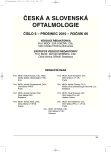Improvement in the Outcome of Visual Impairment using Low Vision Aids in Children
Authors:
E. Gajdošová 1; E. Kukurová 2; A. Gerinec 3
Authors‘ workplace:
Clinical and Academic Department of Ophthalmology, Great Ormond Street Hospital for Children, London, Head of Dpt. Mr. K. K. Nischal, FRCOphth
1; Katedra biofyziky LF UK, Bratislava, vedúca katedry prof. MUDr. E. Kukurová, CSc.
2; Klinika detskej oftalmológie LF UK, DFNsP, Bratislava, prednosta prof. MUDr. A. Gerinec, CSc.
3
Published in:
Čes. a slov. Oftal., 66, 2010, No. 6, p. 266-272
Category:
Original Article
Overview
Introduction:
Low visual aids (LVAs) are the simplest and the most economic method of reducing the consequences of visual impairment (VI). We evaluate prescribing of LVAs in order to improve the quality of life of visually impaired children.
Material and methods:
We retrospectively reviewed the notes of 113 patients (pts.) with VI (visual acuity (VA) 6/18 or worse or with visual field defects) who attended the Low Vision Clinic, F.D. Roosevelt Hospital in Banska Bystrica, between Jan 2000 – Dec 2005. There were 61 boys and 52 girls with ages ranging from < 1 year to < 19 years (mean age 9.4 years, median 9 years).
Results:
Of the 113 notes reviewed, only 109 of patients were cooperative in having their VA formally tested. Blindness (VA worse than 3/60) occurred in 31 pts. (28.4 %) and Low vision (VA worse than 6/18 or equal to 3/60) in 67 (61.5 %). Of the remaining 11 patients, 4 had gross field defects (and good VA), (indicating that the total number with Low vision was 71 (65 %). The other 7 patients had either developmental delay or were too young to perform a formal visual field test. Blindness was caused by perinatal factors in 52 % of cases, prenatal factors in 45 % and postnatal factors in 3 %. Low vision was caused in 74.6 % of cases by prenatal factors. The causes of blindness according to the affected anatomical site were: optic nerve disease in 12 (39 %), cerebral visual impairment (CVI) in 8 (26 %), and retinal disease in 6 (20 %). Low vision was caused by retinal disease in 23 (34.3 %), lens pathology in 11 (16.5 %) and CVI in 10 (14.9 %). 171 LVAs were prescribed to 74 patients (65 %): 76 (44.4 %) were magnifiers, 21 (12.3 %) were hyperoculars or high adds, 65 (38 %) were telescopes and 9 (5.5 %) telescope extensions. An average of 1.5 devices was prescribed for each patient. Every patient who was prescribed an LVA had subjective and objective improvement of their visual function and functional vision.
Conclusion:
Blindness occurred in almost one third of our patients which agrees with the worldwide accepted estimate. The LVA are improving the quality of life of visually impaired children. The prescribing of LVA depends on the individual: it is not possible to anticipate the optical power of the LVA that a patient will need simply from looking at their diagnosis and measuring their VA because there are so many different requirements depending on their age and visual demands.
Key words:
visual impairment in children, low vision, blindness, low vision aids, telescopes, hyperoculars, magnifiers
Sources
1. Doci, J., Juhász, T., Klisenbauer, D.: K problematike slepoty v Slovenskej socialistickej republike. Čs. Oftalmol, 1988, 4 : 241–246.
2. Gajdošová, E., Izák, M., Gerinec, A.: Návrh systému evidencie zrakovo postihnutých detí na Slovensku. In: Folia Strabol Neuroophthalmol, VIII. (I, 5), 2007 : 62.
3. Gerinec, A., Chynoranský, M., Smyková, T.: Príčiny slepoty a slabozrakosti u detí v SSR. Čs. Oftalmol, 1990, 2 : 121–127.
4. Gilbert, C., Foster, A., Negrel, A-D., et al: Childhood blindness: a new form for recording causes of visual loss in children. Bull Worl Health Organ, 1993,71 : 485–489.
5. Gilbert, C. E., Anderton, L., Dandona, L., et al.: Prevalence of visual impairment in children: a review of available data. Ophthalmic Epidemiol, 1999, 6 : 73–82.
6. Kocur, I., Kuchynka, P., Rodný, S. et al.: Causes of severe visual impairment and blindness in children attending schools for the visually handicapped in the Czech Republic. Br. J. Ophthalmol, 2001, 85 : 1149–1152.
7. Thylefors, B.: Avoidable blindness. Bull WHO, 1999, 77 : 453.
8. VISION 2020 Global Initiative for the elimination of avoidable blindness: Action plan 2006-2011. WHO, 2007 : 1–89.
9. World Health Organization: International statistical classification of diseases, injuries and causes of death. Tenth revision. Geneva, 1993.
Labels
OphthalmologyArticle was published in
Czech and Slovak Ophthalmology

2010 Issue 6
Most read in this issue
- Corneal Higher Order Aberrations and their Changes with Aging
- Corneal Cross-linking – Modern Method of Keratoconus Treatment
- Deep Perforating Trabeculectomy – Results after up to Six Years Follow-Up
- Improvement in the Outcome of Visual Impairment using Low Vision Aids in Children
